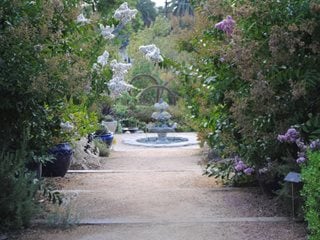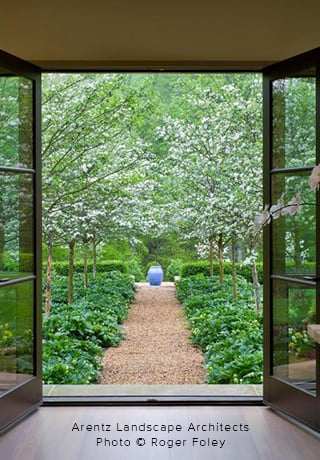10 Elements & Principles of Landscape Design

This garden has it all, including formal lines, focal points, transitional spaces, balance, scale, and texture. Arlington Garden, Pasadena, CA. Photo by: Rebecca Sweet.
Unforgettable gardens all share a common thread: they've mastered the art of blending the elements and principles of garden design. Elements such as color, texture, line, and form evoke personal and emotional reactions, and set the stage for an unforgettable journey. Yet, it's the guiding hand of design principles that ensures these elements are thoughtfully and effectively arranged. Together, elements and principles work in harmony to create stunning and memorable gardens.
1. LINE
Lines play a pivotal role when designing the garden, offering boundless opportunities to shape landscapes and direct movement. In addition, the lines of a garden can also establish patterns, define spaces, sculpt forms, and unify themes within a landscape. Lines are created in various ways: where contrasting materials meet on the ground, like a brick patio next to a lawn; where object edges are outlined against backgrounds, such as tree silhouettes against the sky; or through deliberate material placement, such as fencing.
Directional lines can be quite effective in achieving specific results in the garden. For example, straight lines evoke formality, precisely directing the eye to focal points. Curved lines, on the other hand, appear more relaxed and informal, encouraging leisurely exploration of the garden. Vertical lines create a sense of upward movement, drawing the eye skyward, while horizontal lines suggest lateral movement, making areas appear larger than they actually are.

The winding, curving pathways of the Bellevue Botanical Garden in Washington create a sense of mystery and beckon the visitor to explore what lies beyond. Photo by: Rebecca Sweet
2. FORM & SHAPE
Form and shape are found throughout a garden—from architectural features to specific plants. These elements establish a garden’s style and atmosphere, whether formal, with structured shapes, or informal, with organic lines. When used to describe a plant, shape refers to the outline or silhouette, representing its two-dimensional qualities. On the other hand, a plant’s form, includes its shape combined with its depth, making it three-dimensional. Another way to define form is thinking of a plant when it’s in leaf (the leaves emphasize its depth).

The Kubota Garden in Seattle, WA, incorporates various evergreen forms—from upright exclamation points to weeping, mounding, and conical shrubs. Photo by: Rebecca Sweet.
3. MASS/WEIGHT
In design, mass refers to the visual size of an object or group of objects, such as a planting bed, house, patio, or individual plants. The goal is to achieve balance among different masses, ensuring they harmonize with their surroundings (i.e., planting beds should be proportionate to adjacent lawn areas or hardscape features.) Don’t forget to balance the mass of open (void) spaces with nearby filled spaces when thinking about mass. These voids (often called negative space) have their own visual mass and play a key role in balancing and unifying the landscape. Plan out your empty spaces, and watch how everything else falls into place effortlessly around them.
Additionally, the mass of individual plants within a bed should also align with the overall planting scheme. Each plant contributes to the visual weight and balance of the landscape, so their sizes, shapes, and forms should work harmoniously together.

The oversized foliage of the giant Butterbur (Petasites) has mass and weight similar to the void created by the pond, resulting in a harmonious combination. Stonecrop Garden, NY. Photo by: Rebecca Sweet.
4. COLOR
Color is a powerful design element, adding vibrancy, depth, and visual intrigue to the garden. Whether it's vibrant hues of flowering plants, the lush green of foliage, or color from non-living elements (like hardscaping or artwork), color plays a pivotal role in shaping the mood of the garden. By strategically selecting and arranging plants with complementary or contrasting colors, specific emotions can be created. Warm colors such as reds, oranges, and yellows can energize and create a sense of excitement, while cool colors like blues and purples can evoke tranquility and calm.
Additionally, color can be used to guide the eye, create visual flow, and enhance the overall aesthetic appeal of the landscape.
Read more on using color in the garden.

Creative color combinations, like these blue, white, and purple flowers, can evoke a calm, refreshing atmosphere in the garden. Photo by: Rebecca Sweet.
5. TEXTURE
Texture is an important design element that influences the overall ambiance of a garden. It encompasses the tactile quality and surface characteristics of various materials within the garden, including plants, hardscape elements, and artistic features. By creatively combining different textures, gardeners can achieve specific visual effects.
For instance, plants with coarse textures, such as those with large leaves or bold features, can create a sense of depth or visual interest, while those with fine textures, characterized by delicate foliage or intricate details, impart a softer and subtler aesthetic. Similarly, hardscape materials like stones, bricks, or wood also possess texture, with rough or smooth surfaces adding moments of contrast or repetition.

This serene garden boasts a diverse array of textures, thanks to the varied foliage and bark of the trees. Photo by: Rebecca Sweet.
6. BALANCE, PROPORTION, AND SCALE
Harmony in the garden is achieved through the interconnected and mutually reinforcing principles of balance, proportion, and scale. Balance is achieved through a blend of symmetry or asymmetry, depending on personal preference, resulting in a sense of order and calm. Proportion and scale are two terms often used interchangeably despite the subtle differences between the two. Scale is the relationship of an item to a fixed object (i.e., a nearby house). Proportion, on the other hand, is the size of an object in relation to other surrounding elements in the garden (i.e., plants, artwork, outdoor furniture.) Achieving the perfect blend of these three principles makes your garden feel comfortable, inviting, and peaceful.

In this intimate courtyard at The Cloisters Garden, NY, the large and established apple trees are in scale with the neighboring building, resulting in an inviting garden. Photo by: Rebecca Sweet.
7. RHYTHM AND ECHOES
Rhythm and echoes are a vital unifying force in the garden, establishing a consistent repetition of materials and elements such as form, line, texture, and color. While incorporating a variety of contrasting materials and elements certainly adds interest to the landscape, it is the repetition of these elements that creates rhythm and movement.
However, it’s important to strike the right balance between repetition and contrast. Using too much of a single element can lead to monotony, while using too many elements can create chaos and confusion. Yet, when the right balance is struck between the two, the result is a garden that is rhythmic yet intriguing without overwhelming the senses.

At Innisfree Garden, NY, the color yellow is echoed among the flowers and outdoor seating, creating a rhythmic and harmonious grouping. Photo by: Rebecca Sweet.
8. FOCAL POINT
In garden design, focal points are like the jewels that make a space sparkle, drawing the eye and infusing personality into the landscape. These unique features include captivating artwork, elegant fountains, rare and interesting plant specimens, and breathtaking views.
Regardless of the focal point chosen, its placement is key. This doesn’t mean the focal point needs to be placed in the center of the garden, but wherever it’s placed, it should beckon exploration and ignite curiosity, lending a unique charm to the garden's overall design.

When elevated and placed in an impressive container, the humble agave is given focal point status. Photo by: Rebecca Sweet.
9. FUNCTION
In garden design, the principle of function is making sure your outdoor space works for you, ensuring your garden is as practical as it is pretty. It’s giving thoughtful consideration as to how the space will actually be used, meeting everyday needs and activities. This includes comfortable seating areas for relaxing, areas for activities and games, and pathways that not only meander through the garden but also lead to functional areas such as potting benches, compost bins, or garbage cans. By considering the many different ways a garden will be used, the design can be both visually stunning but also functional.

This multi-purpose garden needs to serve a multitude of functions: a lounging area, a raised bed for cutting flowers, a soothing fountain, and a series of vegetable beds. Photo by: Rebecca Sweet.
10. TRANSITION
The principle of transition in garden design involves creating seamless connections between different areas of an outdoor space. The goal is to smoothly lead people from one area to another, while feeling effortless and natural. Whether transitioning from a sunny patio to a shady garden nook or strolling from a formal area to a more naturalistic setting, it's about making the journey enjoyable and easy. This can be achieved through meandering pathways, using different materials or plants to mark transition zones, or even playing with changes in elevation to add interest. By weaving these transitions throughout the garden, a cohesive flow that invites exploration is created, making every corner feel connected.

Using different paving materials helps visually transition from the sunny patio by the pool to the shady pathway that leads throughout the garden. Photo by: Rebecca Sweet.

BOOK REBECCA AS YOUR NEXT GARDEN SPEAKER!
Fun, passionate, and knowledgeable, three words that describe Rebecca Sweet! See what discussion topics are available and watch a short video as Rebecca explains how her talks will inspire, entertain, and educate gardeners at all skill levels.
RELATED:
8 Rules of Landscape Design
Garden Ideas & Design Inspiration
2024 Trends in Garden Design
Unexpected Surprises in the Garden

